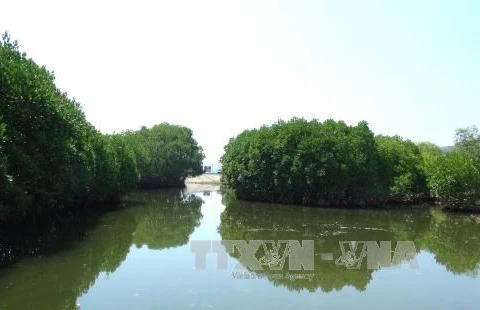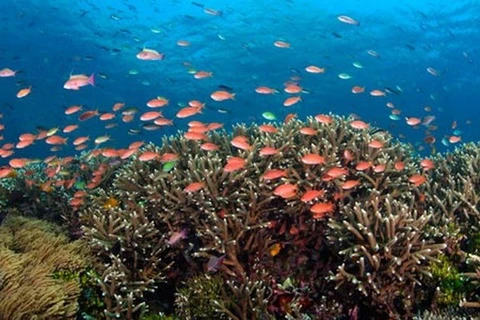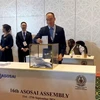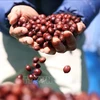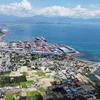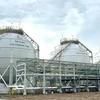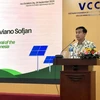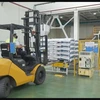Hanoi (VNA) – Vietnam aims to develop the sea-based economy to help the country benefit from the sea and secure national sovereignty and sovereign rights over sea and islands, contributing to the country’s industrialisation and modernisation.
To defend and sustainably exploit sea and islands, priority should be given to coastal areas which cover 28 provinces and cities, accounting for 17 percent of the country’s total area and home to nearly 20 million people.
These coastal areas have achieved significant results, especially tourism, fisheries, water transport and the processing industry. Together with them are the formation and development of coastal cities. However, the areas are facing many challenges regarding the environment, natural resources and other issues related to social safety and security and climate change.
Eco-value is the first thing to mention when talking about the value of coastal areas. Coastal wetlands play an important role in the country’s socio-economic development. The ecosystems of the coastal wetlands are arranged along the coast. They are located at estuaries, lagoons, sandy beaches and wetlands used for farming and aquaculture covering more than 7 million hectares.
In coastal areas there are also island and forest ecosystems. The majority of the 3,000 islands in the sea are located in the northern province of Quang Ninh, forming the World Natural Heritage site of Ha Long Bay recognised by the United Nations Educational, Scientific and Cultural Organisation (UNESCO). Some coastal forests are hot and humid tropical rainforests, or coniferous forests with many species making up valuable biodiversity. Some forests have been included in the list of national parks in need of special biodiversity protection.
By 2015, Vietnam will have 16 marine protected areas, including Tran Island, Co To (Quang Ninh province); Bach Long Vi and Cat Ba (Hai Phong city); Hai Van-Son Tra (Thua Thien Hue province -Da Nang city); Con Dao (Ba Ria-Vung Tau province) and Phu Quoc (Kien Giang province).
Sea and coastal areas offer the country abundant aquatic resources, with annual production output of about 1.8-2 million tonnes. Rainfall in the coastal zone ranges between 1,000-3,000mm a year, creating abundant water resources. In addition, there are promising oil and gas fields, namely Song Hong, Phu Khanh, Cuu Long and Nam Con Son.
The coastal areas of Vietnam are rich in coal and minerals. This includes 500 mineral mines and quarries, with 64 minerals discovered in the coastal areas, such as fuels, metals, non-metals, precious stones and mineral water. There are good quality glass sand deposits which have an explored reserve of over 300 million tonnes (the forecast reserve is about 700 million tonnes). The elements of Titan, Iimenit, Monaxit, Zircon have also been found along the coast.
Besides, many well-known cultural-historical sites are found in coastal areas, such as Hoi An ancient town and My Son Sanctuary in the central coastal province of Quang Nam, the imperial city of Hue in the central coastal province of Thua Thien – Hue and over 100 beaches which attract many domestic and foreign tourists.
Thanks to being located near the international maritime route, Vietnam has favourable conditions for the development of ports and maritime transport. Currently goods transported via sea routes account for 70 percent of the total amount of transported goods, of which import and export activities make up 72 percent.
After 30 years of renovation, Vietnam's economy in general and sea-based economy in particular has flourished. The marine economy contributes between 47 percent and 48 percent to the country’s gross domestic product. Sea-related industries including oil and gas contribute 64 percent, seafood, 14 percent, shipping and port services, 11 percent and marine tourism, 9 percent.-VNA
To defend and sustainably exploit sea and islands, priority should be given to coastal areas which cover 28 provinces and cities, accounting for 17 percent of the country’s total area and home to nearly 20 million people.
These coastal areas have achieved significant results, especially tourism, fisheries, water transport and the processing industry. Together with them are the formation and development of coastal cities. However, the areas are facing many challenges regarding the environment, natural resources and other issues related to social safety and security and climate change.
Eco-value is the first thing to mention when talking about the value of coastal areas. Coastal wetlands play an important role in the country’s socio-economic development. The ecosystems of the coastal wetlands are arranged along the coast. They are located at estuaries, lagoons, sandy beaches and wetlands used for farming and aquaculture covering more than 7 million hectares.
In coastal areas there are also island and forest ecosystems. The majority of the 3,000 islands in the sea are located in the northern province of Quang Ninh, forming the World Natural Heritage site of Ha Long Bay recognised by the United Nations Educational, Scientific and Cultural Organisation (UNESCO). Some coastal forests are hot and humid tropical rainforests, or coniferous forests with many species making up valuable biodiversity. Some forests have been included in the list of national parks in need of special biodiversity protection.
By 2015, Vietnam will have 16 marine protected areas, including Tran Island, Co To (Quang Ninh province); Bach Long Vi and Cat Ba (Hai Phong city); Hai Van-Son Tra (Thua Thien Hue province -Da Nang city); Con Dao (Ba Ria-Vung Tau province) and Phu Quoc (Kien Giang province).
Sea and coastal areas offer the country abundant aquatic resources, with annual production output of about 1.8-2 million tonnes. Rainfall in the coastal zone ranges between 1,000-3,000mm a year, creating abundant water resources. In addition, there are promising oil and gas fields, namely Song Hong, Phu Khanh, Cuu Long and Nam Con Son.
The coastal areas of Vietnam are rich in coal and minerals. This includes 500 mineral mines and quarries, with 64 minerals discovered in the coastal areas, such as fuels, metals, non-metals, precious stones and mineral water. There are good quality glass sand deposits which have an explored reserve of over 300 million tonnes (the forecast reserve is about 700 million tonnes). The elements of Titan, Iimenit, Monaxit, Zircon have also been found along the coast.
Besides, many well-known cultural-historical sites are found in coastal areas, such as Hoi An ancient town and My Son Sanctuary in the central coastal province of Quang Nam, the imperial city of Hue in the central coastal province of Thua Thien – Hue and over 100 beaches which attract many domestic and foreign tourists.
Thanks to being located near the international maritime route, Vietnam has favourable conditions for the development of ports and maritime transport. Currently goods transported via sea routes account for 70 percent of the total amount of transported goods, of which import and export activities make up 72 percent.
After 30 years of renovation, Vietnam's economy in general and sea-based economy in particular has flourished. The marine economy contributes between 47 percent and 48 percent to the country’s gross domestic product. Sea-related industries including oil and gas contribute 64 percent, seafood, 14 percent, shipping and port services, 11 percent and marine tourism, 9 percent.-VNA
VNA

